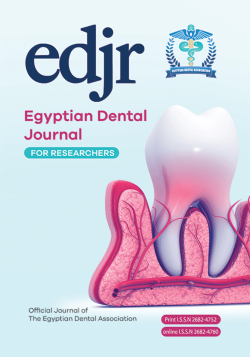Mahmoud Mohammed Abd El Gawad, Ibrahim Hasan El Kalla And Hanaa Mahmoud Shalan,
ABSTRACT
Objectives: The Aim Of This Study Was: 1-To Evaluate Adaptation And Interfacial Micromorphology Of Composite Restorations In Conservative Cavities. 2-To Evaluate Microleakage Of Composite Bonded With Different Adhesives.
Materials & Methods: Conservative Cavities (4�1.5�2mm) Were Prepared In The Occlusal Surfaces Of Ninety Sound Extracted Permanent Molars. Then, The Teeth Were Randomly Divided Into Three Equal Groups, Thirty Molars For Each Group (N=30) According To The Type Of Adhesive. Group 1: Ambar Bond, Group 2: Excite Bond And Group 3: Prompt L-pop. Then All Cavities Were Restored With Composite Resin (Filtek Z250). After That, Fifteen Teeth From Each Group Were Sectioned Buccolingually Into Two Halves To Evaluate Composite Adaptation Under Stereomicroscope (60X) For Both Halves At All Cavity Walls. Selected Specimens Were Examined Under Scanning Electron Microscope (750X) To Detect Interfacial Micromorphology. The Other Fifteen Teeth Were Thermocycled For 1,000 Cycles In Separate Distilled Water Baths Of 5�C And 55�C Then The Teeth Were Immersed In 1% Methylene Blue Dye Solution For 24 Hours At Room Temperature. The Teeth Were Sectioned Buccolingually To Evaluate Microleakage Under Stereomicroscope.
Results: All Specimens Had Voids Ranging From (0.1-1.7mm). Ambar Bond Showed The Greatest Number Of Samples That Had Voids (60%) Followed By Prompt L-pop (40%) And Excite Bond (33.3%). Microleakage Scores Were Highest With Prompt L-pop Followed By Ambar And Excite Bond. Resin Tag Lengths Were Longer With Excite And Ambar Bond As Compared To Prompt L-pop Bond.
Conclusion: Restoration Of Conservative Cavities Without Voids Is Difficult To Achieve. Etch And Rinse System Is Still Considered A Gold Standard Adhesive.


